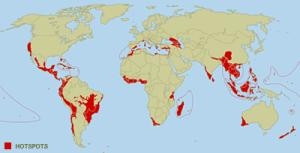What Scale Relevant Lessons Should We Take from the Biodiversity Loss Story?
Little Things Add Up
As with other scale problems biodiversity loss happens little by little – a new mine there, an  industrial farm here, expansion of a city boundary there, a new highway here, etc. There are some large individual projects, such as mega dams for example, which threaten unique indigenous species, but it is the overall level of economic activities that pose the biggest threat to biodiversity.
industrial farm here, expansion of a city boundary there, a new highway here, etc. There are some large individual projects, such as mega dams for example, which threaten unique indigenous species, but it is the overall level of economic activities that pose the biggest threat to biodiversity.
Biodiversity “hotspots,” small areas (only 1.4 % of the earth’s surface) where unusually large concentrations of biodiversity exist, are particularly susceptible to the former type of loss. Unfortunately, these areas are often also of great commercial interest in terms of mining, logging, or for dams.
Protecting biodiversity in these hotspots is particularly important, but so is protection of biodiversity in the areas of less concentration. Biodiversity is threatened globally and needs to be protected globally; concerns about biodiversity hotspots should not reduce efforts to protect the other 98.6 % of the globe with over half the planet’s biodiversity.
Protecting biodiversity globally requires reducing those economic activities which most threaten critical species where ever they occur, and devising methods of ensuring that the global impact of economic growth does not put more critical species at risk.
The Fate of Biodiversity Rest with Civil Society
Despite the many strengths of the various biodiversity treaties, losses are still occurring. These treaties are designed by governments whose highest priorities continue to be economic growth, and as long as this priority remains, biodiversity will be threatened. Governments are only likely to readjust their policy and operational priorities from public pressure to counter corporate influence.
Civil society must continue to play an ever stronger role in pubic education regarding the importance of biodiversity and the threats from continued economic growth.
Reconnecting with Nature
For the developed countries, and the well to do in developing countries, modern civilization is associated with overcoming the limitations of nature. We work, live and play in sheltered environments, we eat processed foods from thousands of kilometers away, we travel great distances in comfort and style, and our wastes are taken out of sight without much fuss. If we do venture into even semi-wilderness, we go well equipped with insulated clothing and a GPS.
We tend to protect what we know and love. Unfortunately, too few of us appreciate the role biodiversity plays in maintaining and enhancing our lives. Understanding that we are totally dependent on nature, that it enriches our lives, that we ourselves are part of nature and not removed from it, are fundamental to protecting biodiversity.
More and continued public education regarding the intimate connections between human survival and well being, and the natural world, is essential to protecting biodiversity.

Profound Ignorance Requires Caution
There are many issues we do not yet understand regarding the relationship between biodiversity and our own well being. Just how much of nature we can appropriate for human use and how much needs to be left intact, is not something we have highly refined answers for.
What we do know about the current episode of human-induced mass extinction of species (see Quick Facts), the human appropriation of Net Primary Production (see Human Appropriation of Natural Capital Unsustainable in Biodiversity:Scale Problem ) and the Ecological Footprint, indicate we are currently exceeding sustainable scale.
Given the potentially dire and irreversible consequences of continued biodiversity loss, application of the precautionary principle is essential to achieve sustainable scale.